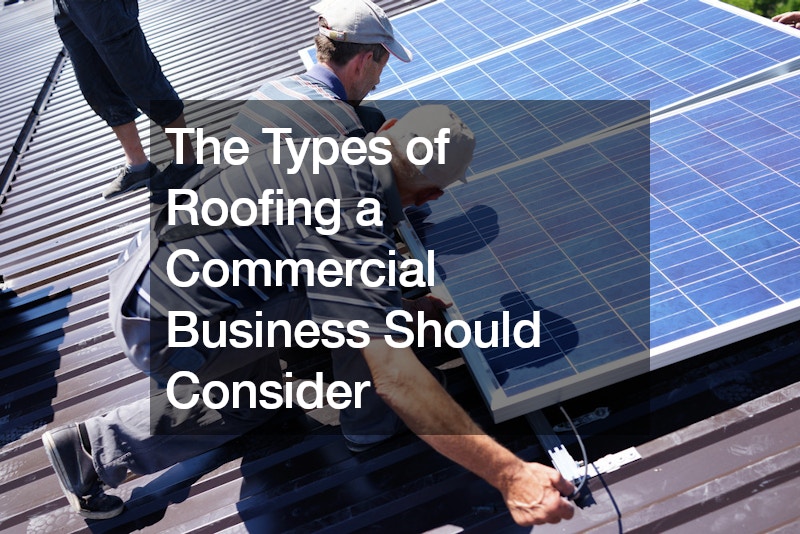
Choosing the right roof type for a commercial business involves considering factors such as building design, climate, budget, and maintenance requirements. Each roof type offers distinct advantages and suitability for different environments and needs. Here’s a comprehensive look at several roof types commonly considered for commercial properties:
1.Flat Roofing
Flat roofs are popular for commercial buildings due to their cost-effectiveness and suitability for large, expansive structures. They provide easy access for HVAC units, solar panels, and other equipment commonly found on commercial rooftops.
Materials commonly used for flat roofs include:
Built-Up Roofing (BUR): Composed of layers of asphalt or tar and gravel or other materials, BUR provides excellent waterproofing and durability.
Modified Bitumen: Similar to BUR but with added modifiers for enhanced flexibility and strength, suitable for climates with temperature fluctuations.
Single-Ply Membrane (TPO, PVC, EPDM): Lightweight and highly reflective, these membranes offer energy efficiency and easy installation. TPO (Thermoplastic Polyolefin) is particularly popular for its durability and resistance to UV radiation.
Flat roofs require regular maintenance to prevent water pooling and ensure proper drainage. Proper installation and maintenance can extend their lifespan and minimize repair costs.
2. Metal Roofing
Metal roofs are known for their longevity, durability, and energy efficiency. They are available in various materials, including:
Standing Seam Metal Roof: Features vertical panels with seams that interlock, providing superior weather resistance and minimal maintenance.
Metal Shingles: Mimic the appearance of traditional roofing materials like slate or tile while offering the benefits of metal, such as durability and lightweight construction.
Metal roofs are resistant to fire, mildew, insects, and rot, making them suitable for a wide range of climates. They reflect solar radiant heat, reducing cooling costs in warmer regions. While the initial cost may be higher than other roofing types, the long-term savings in maintenance and energy make metal roofs a cost-effective choice.
3. Asphalt Shingles
Asphalt shingles are a popular choice for commercial buildings due to their affordability, ease of installation, and versatility. They are available in various styles and colors to complement different architectural designs. Key features include:
Three-Tab Shingles: Traditional, economical option with a flat appearance.
Architectural Shingles: Dimensional and textured, offering enhanced durability and aesthetic appeal.
Asphalt shingles provide good fire resistance and are suitable for moderate climates. Regular maintenance, such as periodic inspection and replacement of damaged shingles, can prolong their lifespan.
4. Green Roofs
Green roofs, also known as living roofs, are gaining popularity for their environmental benefits and aesthetic appeal. They involve growing vegetation on the rooftop, which provides insulation, reduces stormwater runoff, improves air quality, and extends roof lifespan. Green roofs can be extensive (lightweight and low-maintenance) or intensive (lush gardens requiring more maintenance and structural support). Factors to consider include:
Sustainability: Green roofs contribute to LEED certification and other green building standards.
Cost: Initial installation costs may be higher due to structural modifications and waterproofing requirements.
Maintenance: Regular maintenance is necessary to ensure plant health and prevent drainage issues.
Green roofs are suitable for urban environments, offering energy savings, biodiversity, and a pleasant outdoor space for building occupants.
5. Built-Up Roofing (BUR)
Built-Up Roofing (BUR) systems consist of multiple layers of bitumen and reinforcing fabrics, creating a durable and long-lasting roof membrane. BUR roofs are known for their resilience and ability to withstand foot traffic and harsh weather conditions. Key considerations include:
Strength: BUR roofs provide excellent protection against water penetration and UV radiation.
Maintenance: Regular inspections and repairs are essential to address potential leaks and maintain roof integrity.
Cost: While initial installation costs can be higher, BUR roofs offer long-term durability and reliability.
BUR systems are suitable for buildings with heavy foot traffic or equipment installations requiring robust roofing solutions.
Choosing the Right Roof Type
When selecting a roof type for a commercial business, consider factors such as:
Building Design: Ensure the roof complements the architectural style and supports functional requirements (e.g., equipment placement).
Climate: Choose materials that provide adequate insulation, weather resistance, and energy efficiency based on local climate conditions.
Budget: Evaluate initial installation costs, maintenance expenses, and long-term savings in energy and repair costs.
Regulatory Compliance: Ensure the chosen roof type meets building codes, fire safety regulations, and environmental standards.
Consulting with experienced commercial roofing contractors and conducting a thorough assessment of your building’s needs and requirements will help you make an informed decision. Whether prioritizing durability, energy efficiency, or environmental sustainability, selecting the right roof type is crucial for the long-term performance and value of your commercial property. When you are looking for a commercial roofing contractor, you need to make sure they have the necessary skills and experience needed for your business. Your roof is an asset that protects your whole business, making it essential to be put in correctly.
.

